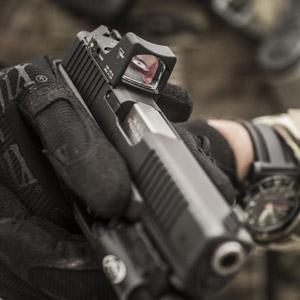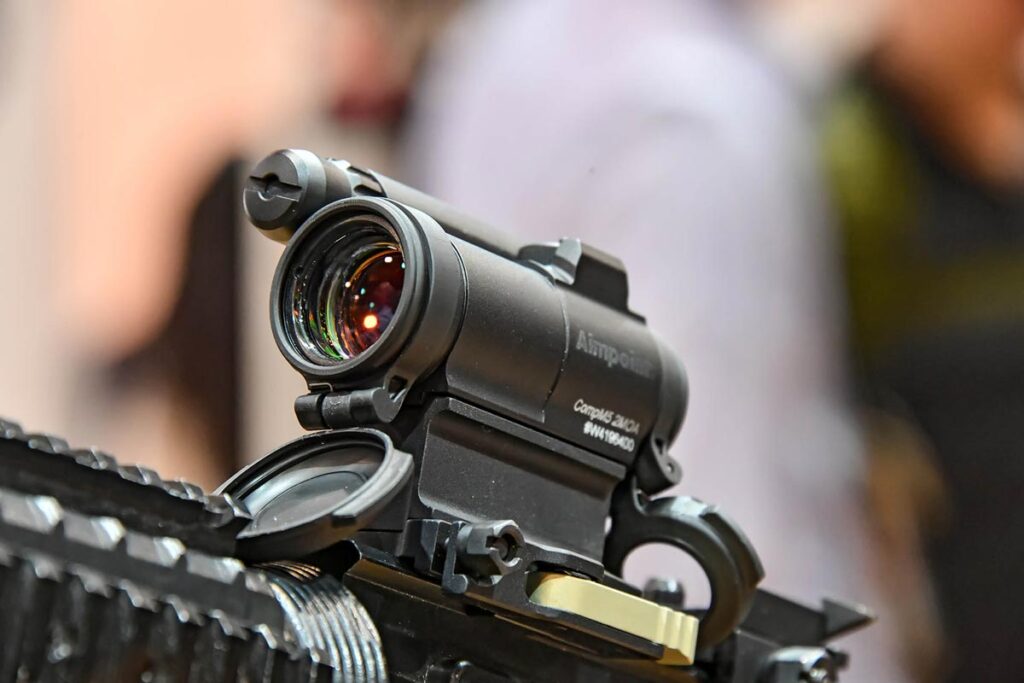Let’s Talk About Red Dots
Whenever I’m teaching classes, and it doesn’t matter which ones, could be Pistol 1 up to Defensive Pistol or Combat Carbine and Pistol one topic that always seems to come up is the topic of red dots. I always get asked if I like them and get asked questions like, “Should I get one?” or “What are some of the pros and cons of them?” so it inspired me to make a post about them.
First off, what are my opinions of red dots?
Personally, I love red dots. I think they’re very beneficial and they’re great to run on both rifles and pistols. They allow for fast target acquisition, which could mean the difference between life and death, and they help with getting follow-up shots on target more accurately. I think in the future you’re going to see a lot more people carrying red dots on pistols and rifles.
“Should I Get One?”
That’s not for me to say. I’m not the one running your gun, and I’m not the one looking through your eyes. There is a little bit of a learning curve on red dots. Don’t think that just because you bought one and put it on your gun you’re never going to miss. That’s not what they’re there for. If you still don’t practice and perfect fundamentals, you’re still going to miss. Another thing they aren’t is a replacement for iron sights. You should still work with irons because if your battery dies in your red dot you’re going to need a backup option.
“What Are Some Pros and Cons?”
Here’s a small list of pros and cons of red dots:
| Pros | Cons |
| Fast target acquisition | Batteries die, you’ll need backup irons |
| Allows for more accurate shots | Not a replacement for fundamentals |
| Can be good for cross-eye dominant shooters | Takes time to learn to use it correctly |
| The dot and the target are together | Cost for a good one |
| Good for low-light | Setup on your pistol/rifle |
| Helps newer shooters shoot with both eyes open | Can be hard with certain eye conditions |
| Shake awakes! | Like any piece of tech, it can break |
| Weather can affect it (especially the cheaper ones) |
So Joe, if they’re so great, how come you listed more cons than pros? Truthfully, there are some more cons than pros. You have to maintain your red dot, just like you maintain your gun. You also have to train with it, constantly, and make sure your zero stays put. But don’t let yourself become dependent on technology, you should still practice religiously with iron sights.

So What Are Some Good Ones?
Some words of warning – just like with most things, you’ll pay more for a good one. You’ll pay more for a Wilson Combat pistol than a Hi-Point, but it’ll perform better as well. You’ll pay more for a Ferrari than a Smart car, but it’ll perform better as well. You get where I’m going with this? I’m not here to say one is better than the other, and which one you select is entirely up to you. I know a lot of pro shooters and special operators and something you’ll notice across the board with them – they all have their own preferred optic, or several optics. I know a few Army Rangers and some use Eotechs and some use Trijicons. Some Marine Recon guys I know love using Eotech, others prefer Aimpoint. The point is one is not the grand-daddy of them all that every single top shooter uses. Expect to pay north of $300 for a decent red dot, and north of $450 for a great one – this goes for pistols and rifles. For instance, a Trijicon RMR for a pistol retails for around $470 (as of this writing), and an Aimpoint Comp M5 goes for north of $900.00. My advice to you is, whatever you end up buying, make sure it has co-witness sights, so you can use your iron sights as backups if your red dot fails.
Are Red Dots The Only Ones There Are?
No. Green dots have come on the market and are coming in strong. Expect to pay a little bit more for a green dot, but they’re actually a little bit better than red dots. Why? Because green is more centralized in the color spectrum, most people can see green easier than red, and green in general is easier to see in daytime than red.
Shake Awakes
Some red dots have a shake awake option. This is pretty cool – when you haven’t moved your pistol for a period of time (usually around 10 minutes) it’ll shut off, which will save the battery. It doesn’t really go all the way off, just into a “sleep mode”, which it will “wake” from when you move it or pick it up.
What Kind of Maintenance Do I Have To Do?
Well, first you’re going to have to zero it. If you don’t know what zeroing is, come in for a rifle class. It’s one of the first things we go over, because to effectively use your rifle and hit what you’re aiming at at a distance, you’re going to have to know your zero and what your holds are going to be at certain yards. You’re also going to have to confirm your zero periodically (how often is up you and how well your particular brand of red dot holds zero). You also need to clean your red dot, all the time, especially on an EDC weapon. You don’t want to have to draw to defend yourself only to see your red dot covered in dirt and grime.

Setup
When you first look into buying a red dot, the first thing you’ll have to ask yourself is, “What red dots fit on my gun?” You need to find one that works with your gun, has the correct mounting plates for your gun, or you’re going to have to send your slide out to be milled so it’ll accept the correct mounting plate. One big problem I see with new shooters mounting a red dot is the lack of Loctite. Your gun is going to vibrate A LOT. From everyday bouncing around to the recoil from your shots, if you don’t use Loctite your screws will loosen and you’re going to run into a host of problems. You’re going to lose your zero, you’re red dot might even fall off if you don’t notice the screws loosening. What if this just happens to happen when you need to use your gun in a self defense incident? Bad time to realize you should’ve used some Loctite on the screws.
Conclusion
Red dots are fun, they have a lot of benefits, and they’re going to be the wave of the future. They’re not just for competition shooters anymore. They also have a learning curve that you’re going to need to spend time (and ammo) working on perfecting. Come in for a rifle class or advanced pistol class and we can go over them. If you do buy one, make sure it’s a good one, not a cheap one (buy once, cry once).
Search
Recent Posts
Archives
Recent Posts
Recent Comments
- Phyllis D on Women’s Only Courses
- Lilly on Illinois CCL
- Salvador P on Rifle 1
- David R on Rifle 1
- Andra D on Illinois CCL

Recent Comments